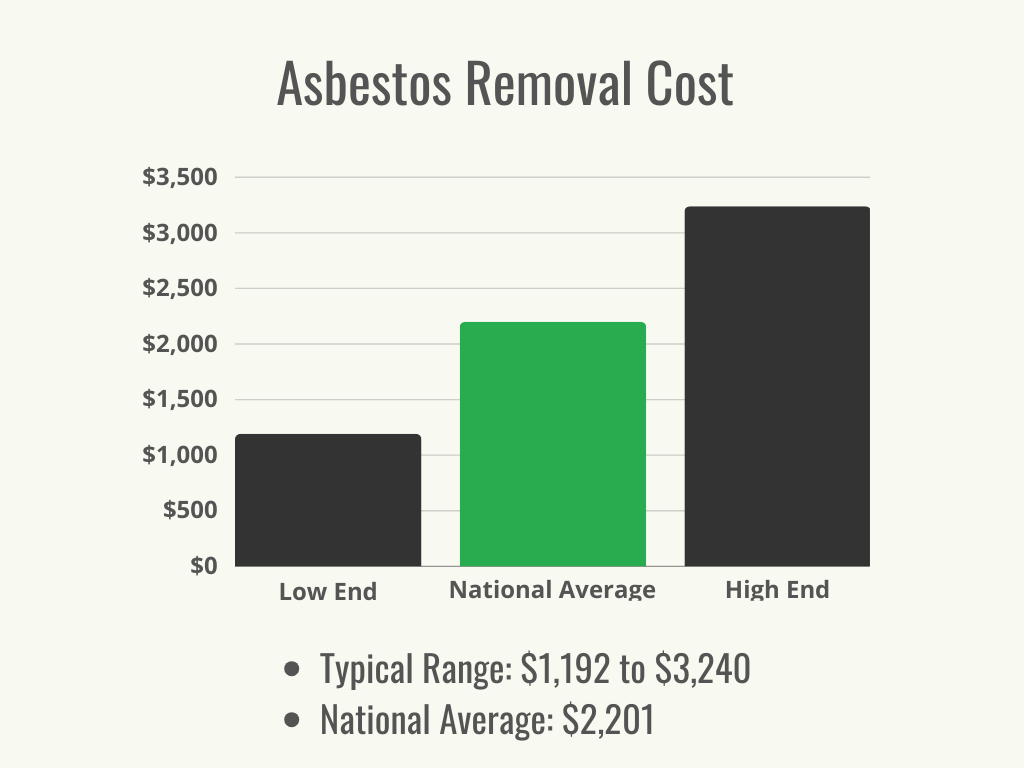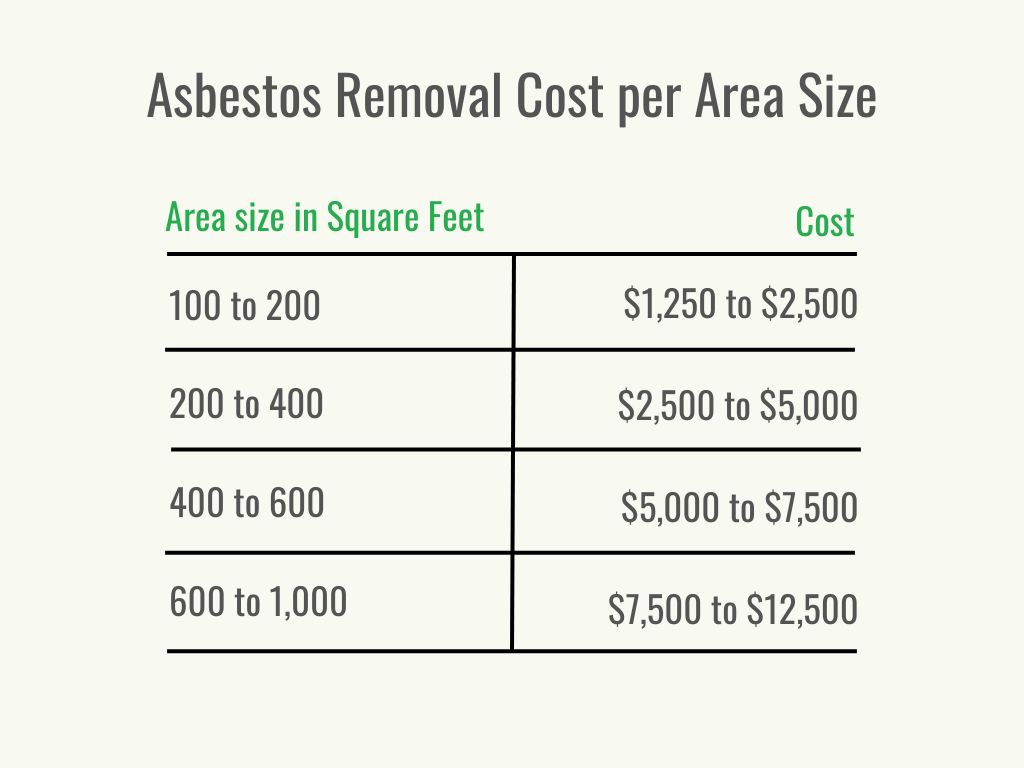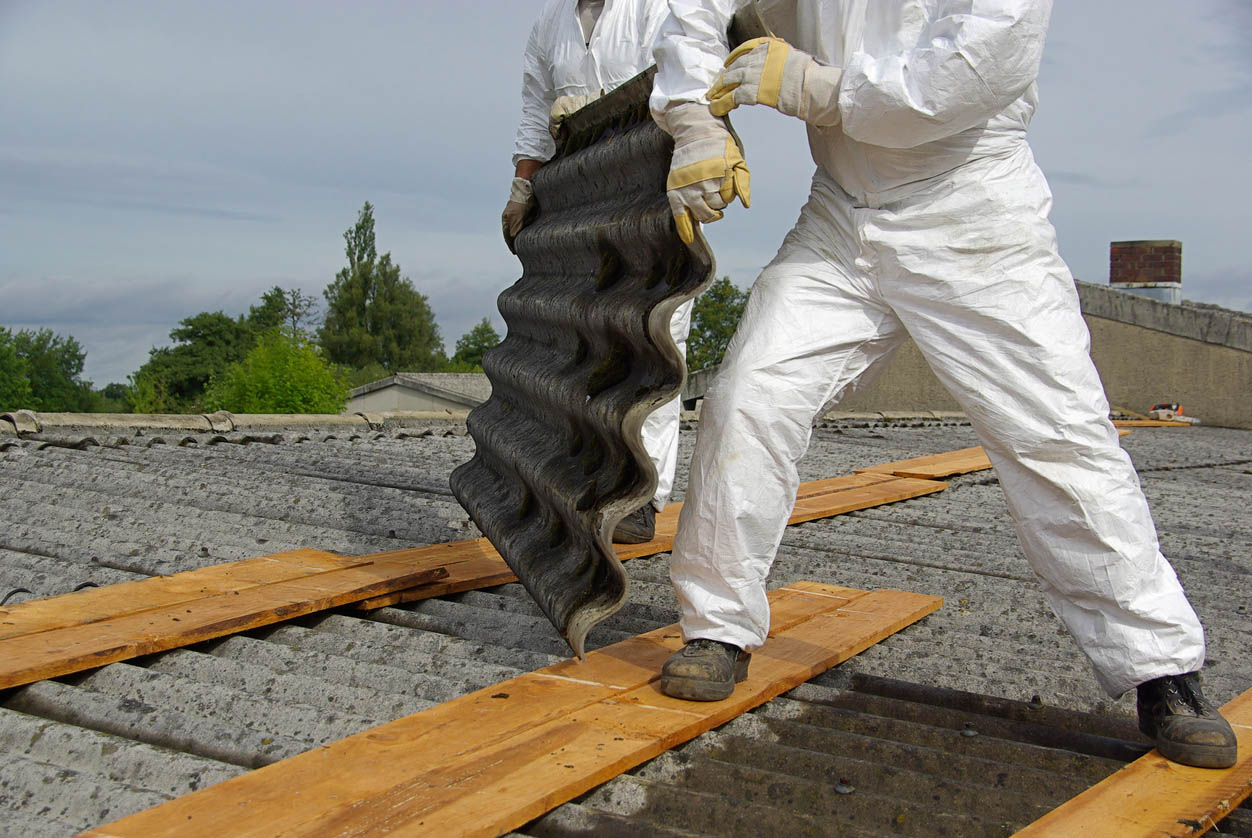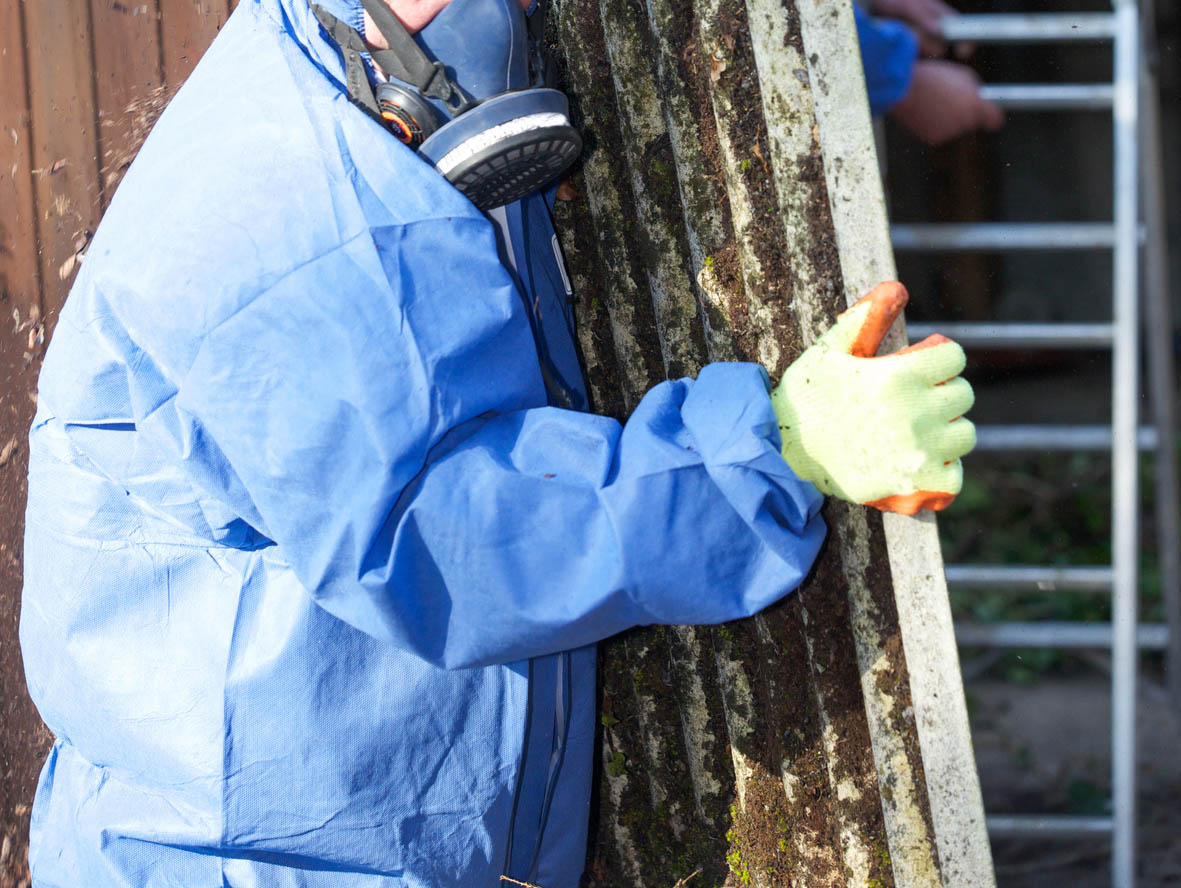

We may earn revenue from the products available on this page and participate in affiliate programs. Learn More ›
Highlights
- The typical range for asbestos removal costs is $1,192 to $3,240 with a national average of $2,201.
- Some factors that can affect what a homeowner pays for asbestos removal include testing, the area size, asbestos type, location, prep work, labor, materials, equipment, cleanup, and disposal.
- Asbestos removal is needed if homeowners are having symptoms of asbestos exposure or are planning a construction project.
- Asbestos removal is a hazardous job that is best left to professionals with the proper experience and protective equipment. Some states also prohibit homeowners from removing asbestos themselves.
Asbestos is a known carcinogen that was used in construction due to its fire and heat resistance. It’s usually found in older homes or buildings built before regulations limited its usage in the United States. If asbestos has been identified, removing it should become a priority. The best asbestos removal companies are certified to remove asbestos using proper safety equipment. So how much is asbestos removal? According to Angi, the average asbestos removal cost is $1,192 to $3,240, with a national average of $2,201. Most of the asbestos removal cost will go toward materials to protect the area from additional exposure during removal. The price may increase depending on the size of the job. We interviewed several experts, including Michelle Whitmer, an asbestos expert and writer with Asbestos.com who has more than 14 years experience covering medicine, cancer and asbestos-related diseases, to learn more about what goes into determining the cost of asbestos removal.
What is asbestos and why is it dangerous?
Asbestos is a naturally occurring mineral that has been used in construction since the 19th century. It is especially common in floor tiles, insulation, and drywall. Hailed for its durability and fire resistance, asbestos was found in almost all buildings until the 1980s. By this time, it was discovered to be a health hazard and was partially banned by the Environmental Protection Agency in 1989. For this reason, “Homes built before the 1980s are more likely to contain asbestos-contaminated building materials,” says Whitmer.
While asbestos is no longer used in new construction, homes built in the middle of the last century may still have asbestos-containing materials. What makes asbestos particularly hazardous is that it is friable, meaning it breaks apart easily into tiny fibers. Once these fibers are inhaled they can cause health issues such as asbestosis, mesothelioma, and other forms of cancer. For this reason, it’s important to ascertain whether asbestos is present before starting construction projects in older homes. The Environmental Protection Agency (EPA) recommends that homeowners leave any suspected asbestos undisturbed to avoid releasing fibers into the air.
Factors in Calculating Asbestos Removal Cost
While the average cost of asbestos removal is $2,201, several factors can affect what a homeowner pays. Preparation and setup for asbestos removal is the most significant factor when determining asbestos removal cost, accounting for approximately 60 to 70 percent of the total price.
Asbestos Testing
According to Whitmer, “It is important to know if your home has asbestos-containing materials because monitoring or abating these materials can prevent exposure. Testing for asbestos helps homeowners make informed decisions to protect their families from exposure.” After a homeowner contacts an asbestos inspection service, a specialist will perform a visual inspection and lab tests.
If it’s not already required by state law, it’s a good idea to use a separate inspection company from the removal company. Testing and inspecting for asbestos usually costs $250 to $850—a wide range due to the variety of regulations from city and state laws. Homeowners can check online for “asbestos removal near me” to learn about local requirements.
Area Size
If many parts of the home or one large area are contaminated with asbestos, costs may be relatively high. Removing asbestos inside the house can range from $5 to $20 per square foot. For a single room that is around 100 square feet, remediation starts at about $1,250. An asbestos remediation project on a large area of 1,000 square feet could cost as much as $12,500.

Asbestos Type
There is more than one type of asbestos, and more dangerous varieties often have a higher removal cost because of the additional safety precautions that must be taken. Amosite is the smallest, and by extension the most dangerous, type of asbestos to remove. It costs about 5 to 10 percent more than other types to remove. On the other hand, chrysotile is the least expensive variety to remove. Crocidolite falls somewhere in the middle.
Asbestos Location
In many cases, asbestos is not found throughout a house but only in particular areas. The more difficult the site is to reach, the more expensive it may be to remove the asbestos. It may cost $8 to $13.50 per square foot to remove asbestos that is found in walls. Asbestos floor tile removal costs $5 to $15 per square foot. Because of their limited accessibility, crawl spaces and small attics are more hazardous to the person removing asbestos, and more care will have to be taken while sealing the room. Removing asbestos from a roof or siding could cost up to $120 per square foot.
Prep Work
Setting up to remove asbestos is a time-consuming process designed to protect workers and homeowners from flying asbestos fibers that should not be inhaled. The HVAC system will be turned off to prevent extra air movement. A decontamination area will be constructed, rooms sealed off, warning signs posted, and disposal containers prepped. Setup costs typically average $240 to $350 per hour, including materials.
Labor
Asbestos removal usually involves a team of people to seal an area and coordinate the removal process. An average project takes about 8 hours to complete, and at least two employees will usually complete the job. Labor costs approximately $75 to $200 per person per hour.
Materials and Equipment
The cost of materials and equipment needed to remove asbestos will also significantly affect the price. A larger exposed area will need more materials to safely seal off the rest of the home or building. Additionally, each person removing asbestos needs new protective equipment like safety goggles, respirators, protective suits, disposable gloves, and rubber boots. A HEPA vacuum will need to be rented or purchased, and sealants, negative pressure airflow fans, or other removal equipment may be required. On average, materials and equipment will cost $450 or more.
Cleanup and Disposal
Each state has its own fees for asbestos removal, though the EPA has set national standards for disposal regulations. A permit to dispose of asbestos usually costs between $50 and $100, while the disposal rates range from $10 to $50 per cubic yard. Any hazardous waste must be labeled appropriately and disposed of in a special landfill to prevent contaminating local water sources.

Additional Costs and Considerations
When considering asbestos removal costs, there are a few other things to keep in mind. Removing asbestos from a commercial building often includes more areas than a residential house. If the asbestos doesn’t require removal, encapsulating or repairing the area might be possible at an additional cost.
Residential vs. Commercial Buildings
Generally, a residence and a commercial building have the same challenges for asbestos removal. The primary difference is that a commercial space often has more square footage than a residence, and it may cost more to seal off the area during the prep. Removal and disposal techniques are the same for a commercial building as for a residential house. Still, only a licensed professional can do asbestos abatement in a commercial building or multifamily dwelling in some states.
Asbestos Removal vs. Encapsulation
The primary concern with asbestos is that airborne fibers can be inhaled and cause chronic health problems. According to Whitmer, “Options for abatement depend upon the material and may include encapsulation or removal.” Not all asbestos has to be removed unless it’s at risk of becoming airborne, as is often the case during a remodel. One option to avoid removing asbestos is to encapsulate or seal it instead—if an inspection proves this is a safe option. A special coating is applied to bind the fibers together, and this is commonly done in ductwork, costing about $2 to $6 per square foot. Overall, encapsulation costs 15 to 25 percent less than asbestos removal costs.
Home Repairs
Asbestos siding repair cost will vary due to state regulations but average $700 to $5,000. Asbestos siding removal costs $7 to $9 per square foot. Removing all asbestos siding isn’t required in some states, which means homeowners won’t have to shell out the cost of brand-new siding on their house. Encapsulating the siding can be cheaper than doing a complete repair when allowed. Suppose ductwork, drywall, tiles, or other materials with asbestos cannot be encapsulated. In that case, they’ll need to be removed and then repaired, which is an additional cost beyond the asbestos removal cost.
Relocation Costs
Because removing asbestos can release fibers into the air, it’s typically required that any residents be away from the home until the removal is completed. Depending on the amount of asbestos being removed this project can take several days, so it may be necessary to pay for alternative accommodations for a few nights.
Asbestos Removal Cost by Type of Location
Removing asbestos from a garage, house, or office building is typically the same process, however, areas with little or difficult access or large surface areas will have a higher price for removal. On average, homeowners can expect to spend between $5 and $20 per square foot for asbestos removal inside a building.
| Asbestos Location | Removal Cost per Square Foot (Materials and Labor) |
| Attic insulation | $11 to $25 |
| Basement | $5 to $20 |
| Flooring and floor tiles | $5 to $15 |
| HVAC ducts | $35 to $55 |
| Pipe insulation | $5 to $15 |
| Popcorn ceilings | $3 to $7 |
| Roof and shingles | $50 to $120 |
| Siding | $7 to $9 |
| Soil | $4 to $6 |
| Walls and drywall | $8 to $13.50 |
Attic Insulation
Asbestos is often found in old attic insulation. Some attics have plenty of room to work, while others are difficult to access. By nature of how insulation is made, it’s more dangerous to remove asbestos-laden insulation since fibers easily come loose. For those who aren’t sure what asbestos insulation looks like, it’s a good idea to have a professional inspect the insulation in their attic before disturbing it. Homeowners can expect to spend $11 to $25 per square foot for removal.
Basement
Basement asbestos removal can cost anywhere from $5 to $20 per square foot. One of the biggest cost factors is whether the basement is finished or unfinished. Because asbestos-containing materials are more accessible in unfinished basements, removal will cost about 25 percent less.
Flooring and Floor Tiles
Vinyl floors are one of the most common places where asbestos is found in old homes. Unless the flooring is damaged and the fibers can be vacuumed or swept into the air, simply encapsulating the floor may be sufficient to reduce exposure.
In some cases, tile and tile mastic used to glue them down may have asbestos in them. Asbestos tile removal typically costs between $5 and $15 per square foot to remove, plus an additional $800 to $4,500 to replace. Simply encapsulating asbestos floor tiles is possible if an inspection has shown there is no danger of exposure. Another option is to cover it with new flooring of almost any kind. Most older tiles are barely thicker than ⅛ inch, so the floor height won’t rise appreciably.
HVAC Ducts
Ducts are usually entirely removed since asbestos is typically used to hold ductwork pieces together. Since ducts are in enclosed spaces and linked to the ventilation system, removal is a more delicate process. On average, removing asbestos ductwork costs $35 to $55 per square foot.
Pipe Insulation
Asbestos can be found glued or taped around some pipes as insulation. Removal depends on how the material was affixed and whether the pipe section or entire pipe will be removed. Removing wraps from pipes has a per-linear-foot cost of $2 to $5. Other projects may cost $5 to $15 per square foot.
Popcorn Ceilings
Popcorn ceilings and old ceiling tiles are common asbestos locations. Asbestos popcorn ceiling removal costs $3 to $7 per square foot. Alternatively, the ceiling could be eligible for an encapsulation spray which runs between $2 and $6 per square foot. Asbestos ceiling tiles can also be encapsulated at the same price.
Roof and Shingles
Steep roofs can be dangerous to work on, and they have a large surface area—both of which increase the price. Containment is another concern since removing asbestos on a windy day can make the process challenging. Removing asbestos from a roof averages $50 to $120 per square foot, and replacing a roof could cost $5,800 to $12,500.
Siding
Asbestos used to be a common siding material because it is resistant to fire. It costs between $7 and $9 to remove asbestos siding. Not all states require asbestos siding removal, so those who choose to encapsulate it instead can expect to pay a slightly lower price.
Soil
Decades ago, old landfills used to be bulldozed and filled in before being rezoned for commercial construction. Hazardous materials weren’t always adequately disposed of, so asbestos sometimes leached into the soil. Removing asbestos from soil typically costs $4 to $6 per square foot.
Walls and Drywall
For homes built before 1986, it’s not uncommon to discover that most of the walls are contaminated with high amounts of non-friable asbestos. In a worst-case scenario, the walls would need to be removed and replaced at $8 to $13.50 per square foot. An inspection may reveal that it’s safe enough to have the walls encapsulated instead. A high-grade specialized sealant can help ensure the asbestos won’t be an airborne risk. Encapsulating typically costs $2 to $6 per square foot.

Do I need asbestos removal?
If asbestos is determined to be a hazard within the home, it will need to be removed. But contrary to popular belief, finding asbestos in the home doesn’t automatically mean it has to be removed. Sadly, some diseases take years to appear after asbestos exposure, so it’s best to check any areas of concern promptly. Any sign of water damage or tearing is an indication that asbestos may be loose and need to be removed; otherwise, encapsulation may be sufficient. “Do not disturb asbestos-containing materials until a professional can address the concern,” Whitmer warns.
Asbestosis Symptoms
People who have had long-term asbestos exposure may develop a chronic lung disease called asbestosis. According to the Mayo Clinic, symptoms usually develop 10 to 40 years after exposure, making it challenging to identify when or where the exposure occurred. The fibers are trapped in the lungs and cause scarring over time. Some common symptoms include a dry, persistent cough, shortness of breath, loss of appetite, chest tightness or pain, and widened fingertips and toes (also called clubbing).
Home Improvement Projects
Older homes are often slated for remodeling projects, but many materials may be unknowingly laced with asbestos. What asbestos looks like can vary depending on the variety and the material it is used in, but keep watch for the telltale white, brown, or blue fibers while demolishing areas of the house. If asbestos is found, it will be necessary to carefully handle the area to maintain the health of anyone working on the remodel. Cover the exposed material tightly until it can be properly inspected and tested, then proceed based on the recommendation.
Asbestos Removal: DIY vs. Hiring a Professional
Despite the hazards of asbestos removal, there are no federal regulations preventing homeowners from doing their own asbestos removal. However, some states have restrictions in place due to hazardous conditions. While some asbestos DIY kits are available for those wondering how to test for asbestos or how to remove asbestos, be advised that they provide only minimal protection and may not include all the necessary equipment.
Since labor is not the most significant factor for asbestos removal costs, homeowners won’t save a lot of money doing it themselves. Asbestos removal is best left to the pros who are appropriately trained and certified to contain, clean, and dispose of hazardous materials. “The U.S. Environmental Protection Agency recommends hiring licensed asbestos professionals to gather samples for asbestos testing. Trained and accredited professionals know how to safely collect samples, and they have the costly equipment required to do the job,” says Whitmer. “For example, trained professionals wear a HEPA-filter respirator mask, disposable coveralls, rubber boots, safety goggles, and gloves to collect samples. They also understand the intricate steps required to prepare the home and clean it up. Personal decontamination is equally as intricate to prevent exposure to microscopic asbestos fibers.”
Special suits and respirators protect employees during the removal process, and homeowners are sometimes asked to leave the home for their own safety. The entire area is carefully sealed off, and then water is used to dampen the fibers to prevent excessive floating as they are captured. When done correctly, asbestos removal won’t contaminate the rest of the house. A licensed asbestos removal company will clean every surface and perform air testing before removing the barriers and doing a final cleaning. From start to finish, professionals are capable of handling the job with ease.
How to Save Money on Asbestos Removal Cost
Dealing with exposed asbestos can be a frustrating and unexpected cost, especially considering that asbestos removal isn’t covered by insurance in most cases. It’s natural to want to find ways to save money on asbestos removal costs, especially if new materials like flooring or drywall will have to be installed. Here are some money-saving ideas for asbestos removal:
- Keep inspection and removal separate. Use a third-party inspection company to test for asbestos rather than having the removal company test. This avoids any conflicts of interest since you don’t want to pay for asbestos removal if there isn’t a problem.
- Prioritize safety. Only use encapsulation methods when it’s legal and safe to do so. Saving money isn’t worth it if it puts your family’s health at risk.
- Shop around. Get quotes from multiple reputable companies to ensure you’re getting a good deal.
- Apply for assistance. Homeowners will want to look for local asbestos removal programs. While you may not get free asbestos removal, it’s worth checking to see if your local government has a program for asbestos removal grants or other assistance to help homeowners offset removal and disposal costs.
Questions to Ask About Asbestos Removal
Removing asbestos can be a daunting process, especially if a significant amount of asbestos has been found. There are several factors to consider, all tailored to individual situations. A certified asbestos removal professional can confidently answer any questions and provide guidance. The following questions can help facilitate this conversation.
Ask the inspector:
- Are you certified to inspect and test for asbestos?
- How much do you charge to physically inspect for asbestos?
- How quickly do the test results come back?
- Do we go over the results and recommendations in person or over the phone?
- Do you provide the results to the asbestos removal company, or do I share them?
- Are there any special state regulations that affect how the asbestos in my house will have to be handled?
- Will I need an additional inspection after the job is done?
Ask the asbestos removal company:
- May I see your credentials for removing and disposing of asbestos?
- Have you ever had safety violations from the local pollution board or local workers’ safety program?
- Have you worked on a removal project like mine?
- Will you provide a contract stating work scope, cleanup plan, and regulations that must be followed?
- How long will it take to complete?
- Can I stay nearby during the process?
- Do you use new protective gear at each jobsite?
- How will you prevent fibers from being released into the house?
- How many employees will you send?
- Is your team able to remove contaminated ductwork (or shingles, tile, or drywall as your situation requires)?
- Will a qualified subcontractor need to be hired to help remove any materials like plumbing?
- How do you collect and remove the contaminated materials?
- What is your cleanup process?
- Will you complete an air test before removing the containment seals?
- How soon can I have new or replacement parts and materials installed?
FAQs
For those who require asbestos removal in a residential or commercial building, there are bound to be some questions about the process. Talking with an asbestos inspector or removal expert can help clarify any questions. For quick reference, here are some of the most frequently asked questions and answers.
Q. How do I hire an asbestos contractor to work in my home?
Before hiring a contractor, a different company will first need to perform an inspection.
You can call your local health department for a list of certified inspectors who can complete a visual inspection and get lab testing done on collected samples. The U.S. Consumer Product Safety Commission (CPSC) recommends that homeowners check the company’s reputation on the Better Business Bureau, as well as check with their local air pollution control board to see if the company has any recorded safety violations before calling for a quote.
Q. How will the contractor remove asbestos from my house?
Any materials or protective gear that comes in contact with asbestos will be disposed of. The contractor should have large, leak-proof, heavy-duty plastic bags to collect all waste. It’s best to avoid breaking the asbestos materials into smaller pieces to avoid releasing more fibers. All surfaces will be mopped down or vacuumed with a special HEPA vacuum specially rated to trap hazardous particles like asbestos. The containment seals will be carefully deconstructed and removed in plastic bags as well.
Q. What is the difference between a friable and non-friable asbestos?
Friable asbestos is more dangerous to humans. It’s crumbly and easily releases toxic particles into the air. Non-friable asbestos is stable and resists releasing fibers easily unless damaged. Old floor tiles and some walls contain non-friable asbestos.
Q. How long does asbestos removal take?
A typical asbestos removal job takes a team of people only a day or two to complete, but larger jobs may take up to a week. However, getting an inspection and test results takes longer, depending on the number of samples and testing performed.
Sources: Angi, HomeAdvisor, Fixr, Forbes, HomeGuide
